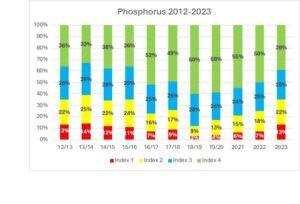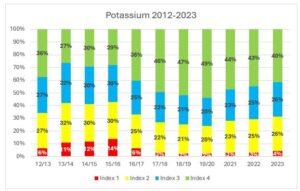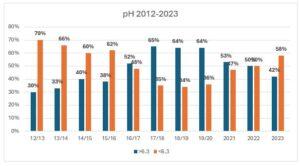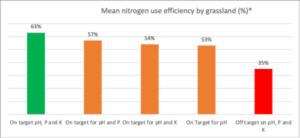Get a 24 hour weather forecast
Soil chemical health is on the decline. 2022 was poorer than 2021 and 2023 results have shown a further decline since 2022. On soil P index, in 2023 we had 13% of the soil analysed showing index 1, this is up from 6% in 2021 and 3% in 2019. Soil K and Ph analysis are showing similar trends.



The impact of soil chemical health on Irish farms?
In an era of declining nitrogen fertiliser allowances, soil chemical health is hugely important to allow our farmers to continue to grow the grass needed to drive our sustainable and profitable farming systems.
Going forward, we will be allowed to spread c.212.5 kg of chemical nitrogen per ha. There is always losses associated with spreading nitrogen.
Our goal is to minimize them, maximizing the nitrogen uptake by the plant, lowering the nitrogen surplus per ha, decreasing your farms environmental impact and improving your farms financial sustainability.
If your pH and P and K indexes are on target your grass get access to c.65% of the 212.5kg per ha of nitrogen that was spread or c.138kg per ha.
If your pH and P and K indexes are off target your grass will only get access to 35% of the 212.5kg per ha of nitrogen that was spread or c.74kg per ha.
That’s a loss of other 64 kg of nitrogen per ha. Every small bag or 50kg of CAN contains 13.5kg of N.
Save your back, save the diesel, fix your soil chemical health.

Our number 1 priority to improve soil chemical health:
By fixing your soils pH alone you increase the efficiency of the nitrogen you spread from 35% to 53%. This will give your grass access to a further 38kg N per ha, meaning that of the 212.5kg N per ha you spread your grass will now have access to 113kgs of it. That a free N and the grass growth that free N. In 2022 Irish farmers applied 1.4 m tonnes of time. This fell to ~ 0.7 m tonnes in 2023 (Industry estimate) due to limited opportunities to apply lime as a result of adverse weather conditions.
Keeping silage and fertiliser interactions in mind, across the summer, as a job of upmost priority should be applying spread lime when and where we can.
How to improve soil chemical health status?:
There is a limit on our N use not our P use (once our indexes indicate a need for P) or our K use. We must break the linkage between N, P and K within our products purchases and where needed by NP, NK, PK, P and K products.
To date this year have you spread chemical P and K where needed? If not, if you have P allowances but you want to limit you N application consider spreading some 0-10-20 or super P. Without a P allowance but in need of some K use muriate of potash. This can be spread all year round and if silage ground got limited or no slurry application or if you took round bales off your grazing ground there’s a real strong likelihood it will need K.
But long term to improve your farms soil chemical health and to maximise the efficiency of the chemical fertiliser you are spreading:
For Dairygold Farmers Soil Health is Pillar 3 on the Grass Roots Bonus Scheme
Consult your Dairygold Area Sales Manager today for more information.